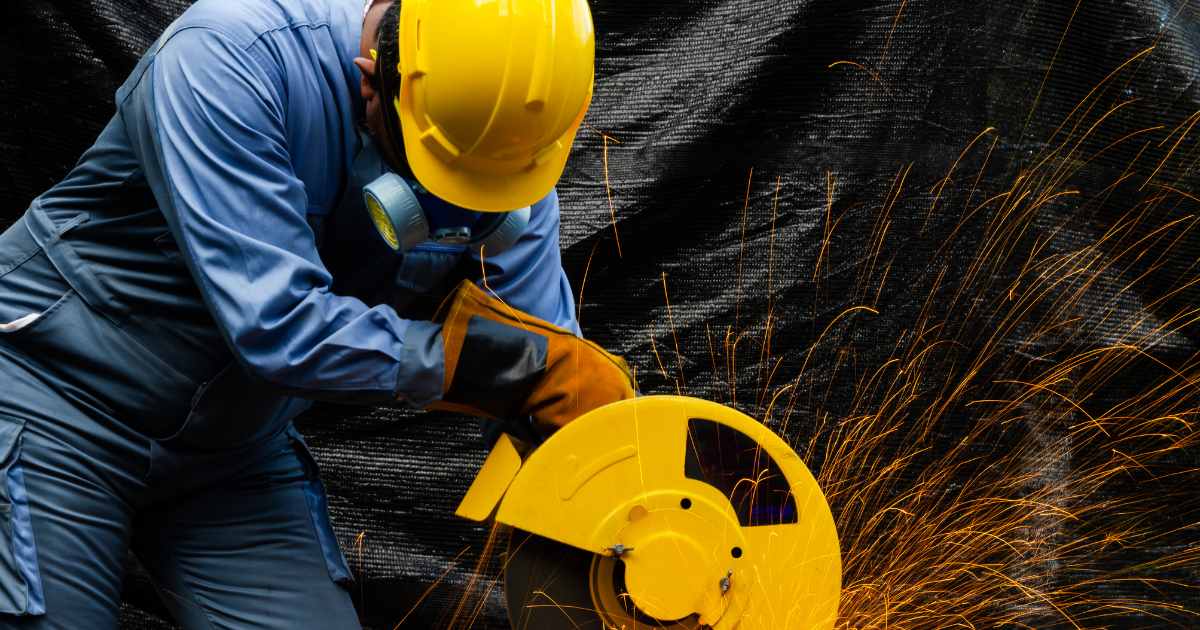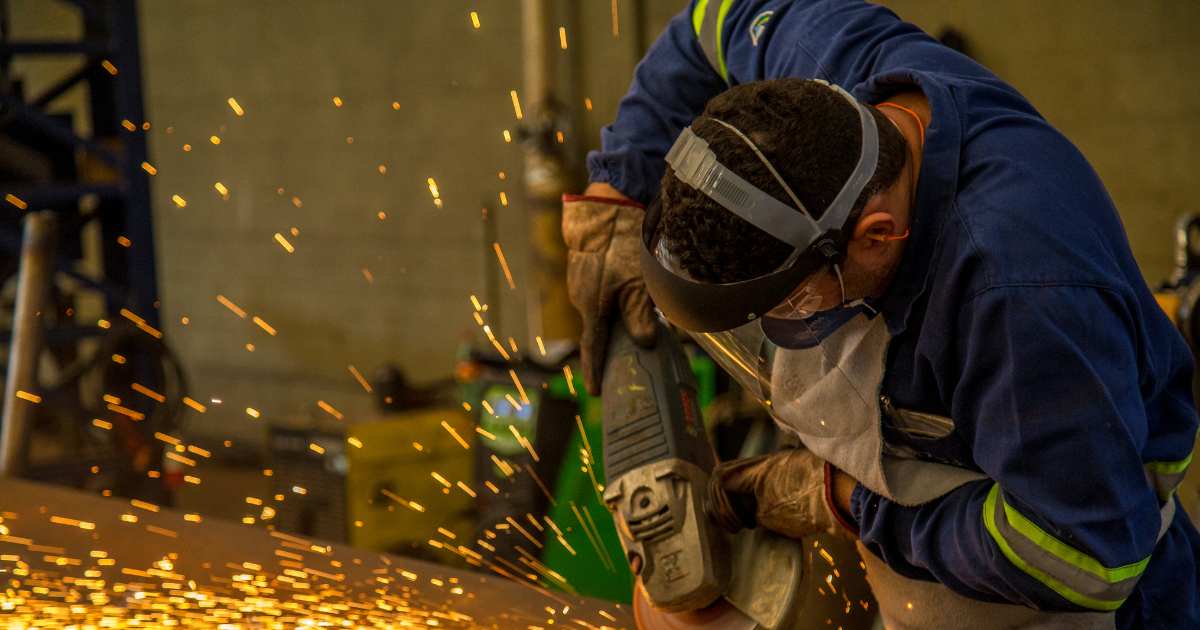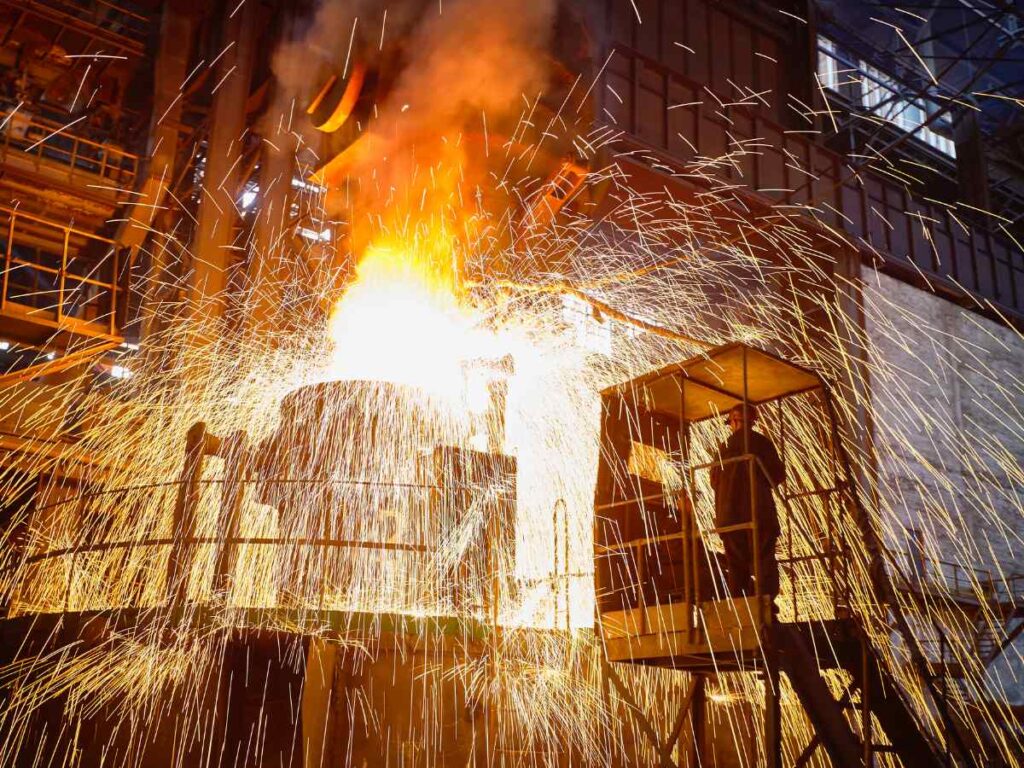Ensuring safety when dealing with steel and aluminum work is necessary. The inherent nature of these materials, their weight, and the various processes involved in their manipulation pose a lot of risks to workers if proper safety precautions are not implemented.
The consequences of neglecting safety measures in this field can be serious. Mishandling heavy steel components or working with molten aluminum can lead to incidents such as falls, burns, cuts, and crush injuries. Hazardous chemicals, such as welding fumes and metal dust, increase the risk of respiratory issues and long-term health complications. By recognizing and prioritizing safety, individuals and organizations can proactively reduce these risks, safeguard the well-being of workers, and create an aluminum and steel safety work environment.
Understanding Hazards in Steel and Aluminum Work
Identifying Potential Risks
Before implementing safety measures, identify and assess potential steel and aluminum work risks. This proactive approach allows for targeted strategies to reduce hazards effectively. By conducting thorough risk assessments, professionals can identify specific areas of concern and develop tailored aluminum and steel safety protocols.
Common Safety Hazards in Steel and Aluminum Work
- Physical Hazards
Physical hazards involves a range of dangers related to the physical properties of steel and aluminum materials. These hazards include heavy loads, falling objects, sharp edges, rotating machinery, and potential crush injuries. Implementing proper lifting techniques, utilizing appropriate equipment, and establishing clear protocols to prevent physical accidents are essential.
- Chemical Hazards
Steel and aluminum work involves using chemicals that can harm workers’ health. Welding fumes, metal dust, and chemical solvents are potential chemical hazards. Inhalation or skin contact with these substances can lead to respiratory issues, skin irritations, and long-term health complications. Proper ventilation, personal protective equipment (PPE), and safe handling procedures are needed to reduce these chemical hazards.
- Ergonomic Hazards
Ergonomic hazards are associated with repetitive movements, awkward postures, and improper ergonomics in the workplace. Steel and aluminum work often involves lifting heavy objects, operating machinery, and working in constrained spaces. Prolonged exposure to these ergonomic hazards can lead to musculoskeletal disorders, strains, and fatigue.
- Fire and Explosion Hazards
Aluminum and steel safety work environments have fire and explosion risks due to welding, cutting, grinding processes, and flammable materials. Sparks, hot work, combustible dust, and flammable gases pose serious threats. Implementing fire prevention measures, ensuring the availability of firefighting equipment, proper storage and handling of explosive materials, and promoting fire safety awareness are important to reduce fire and explosion hazards.
Implementing Safety Measures
Training and Education
- Proper Use of Personal Protective Equipment (PPE)
Personal protective equipment is necessary in safeguarding workers from various hazards. Training should focus on the correct selection, fitting, and usage of PPE, including safety goggles, gloves, helmets, hearing protection, respiratory protection, and protective clothing.
- Equipment Handling and Maintenance
Proper handling and maintenance of equipment are needed to prevent accidents and malfunctions. Training should cover safe equipment operation, including correctly using tools, machinery, and lifting devices. Workers should be trained on equipment inspection, maintenance procedures, and promptly reporting issues.
- Safe Work Practices and Procedures
Promoting safe work practices and procedures is necessary to minimizing hazards. Training should include instruction on identifying and reporting unsafe conditions, proper material handling techniques, and following established protocols. Encouraging open communication and actively empowering workers to participate in safety initiatives can foster a safer work environment.
Risk Assessment and Mitigation
- Hazard Identification and Evaluation
A comprehensive hazard identification process is the foundation of risk assessment. It involves identifying potential hazards specific to steel and aluminum work environments, considering materials, equipment, methods, and work conditions. This step requires involving workers, supervisors, and safety professionals to identify and evaluate risks systematically.
- Risk Control Measures
- Engineering Controls – Engineering controls involve modifying or redesigning equipment, processes, or systems to minimize hazards. Examples include installing safety guards on machinery, implementing ventilation systems to control airborne contaminants, and using noise control measures.
- Administrative Controls – Administrative controls involve establishing policies, procedures, and work practices to reduce risks. This includes implementing safety protocols, providing training and supervision, scheduling regular equipment inspections and maintenance, and ensuring compliance with safety regulations.
- Personal Protective Equipment (PPE) – Personal protective equipment is a necessary protective barrier when engineering and administrative controls are not enough. PPE includes safety goggles, gloves, helmets, respirators, and protective clothing.
Worksite Organization and Maintenance
- Housekeeping Practices
Good housekeeping practices prevent workplace accidents and maintain a safe work environment. This involves keeping the worksite clean, orderly, and free from clutter. Removing debris, waste materials, and tripping hazards like loose cables or tools helps prevent slips, trips, and falls.
- Regular Equipment Inspections
Regular equipment inspections help to identify potential hazards and ensure proper functioning. This includes conducting routine checks of machinery, tools, lifting equipment, and safety devices. Reviews should cover structural integrity, electrical systems, moving parts, and safety features.
- Emergency Preparedness
Being prepared for emergencies is necessary to protect the well-being of workers and minimize the potential impact of unforeseen incidents. Organizations should have comprehensive emergency preparedness plans, including procedures for handling fires, spills, accidents, and medical emergencies. Emergency exits should be marked, accessible, and free from obstructions.
Aluminum and Steel Safety Material Handling
 Lifting and Carrying Techniques
Lifting and Carrying Techniques
- Assess the load: Before lifting, evaluate the weight, size, and stability of the load. Determine if assistance or mechanical lifting aids are necessary.
- Maintain proper posture: Stand with feet shoulder-width apart, bend your knees, and keep your back straight. Avoid twisting or bending at the waist while lifting.
- Use leg muscles: Engage the leg muscles to lift the load rather than relying solely on the back. Push up with the legs while keeping the back straight.
- Get a secure grip: Use gloves or hand protection to ensure a secure grip on the load. Avoid lifting with just the fingertips.
- Keep the load close to the body: Hold the load close to the body to maintain balance and reduce strain on the back.
- Avoid sudden movements: Lift and steadily carry the load. Avoid sudden jerks or twists that can strain muscles or cause the load to shift.
Proper Storage and Stacking Procedures
- Designated storage areas: Establish dedicated areas for storing steel and aluminum materials. Clear signage and markings should indicate the locations and types of materials allowed in each room.
- Stable stacking: When stacking materials, ensure a stable and secure arrangement to prevent collapses or shifting. Use appropriate stacking aids, such as pallets, racks, or containers, to maintain stability.
- Weight distribution: Distribute the weight evenly when stacking materials. Heavier items should be at the bottom, with lighter things on top to preserve peace and prevent toppling.
- Height limitations: Determine the maximum safe stacking height based on the weight and stability of the materials. Avoid exceeding these limits to prevent the risk of toppling or instability.
- Clear walkways and exits: Ensure that aisles, walkways, and emergency exits are clear of stacked materials. This allows for safe movement and facilitates swift evacuation during emergencies.
Handling Sharp Edges and Protrusions
- Wear appropriate PPE: Use gloves, safety goggles, and protective clothing to minimize the risk of cuts, abrasions, and eye injuries.
- Inspect materials: Before handling, inspect steel and aluminum materials for sharp edges, burrs, or protrusions. File or deburr them as necessary to eliminate potential hazards.
- Use handling tools: Use appropriate means, such as clamps or tongs, when moving materials with sharp edges or protrusions. This helps maintain a safe distance between hands and potential injury points.
- Secure materials during transportation to prevent shifting or movement that may expose sharp edges or protrusions.
Fire Safety Precautions
Preventing Fire Measures
- Good housekeeping: Maintain a clean and clutter-free workspace, regularly removing combustible materials and waste.
- Proper storage and handling: Store flammable materials in designated areas away from ignition sources, such as sparks or flames. Follow appropriate handling procedures for explosive substances.
- Electrical safety: Make sure that the electrical systems and equipment are properly installed, grounded, and maintained. Regularly inspect and repair any damaged or faulty electrical components.
- Hot work permits: Implement a permit system for conducting hot work activities, such as welding or cutting. This ensures that proper precautions are taken and that fire safety measures, such as fire blankets or extinguishers, are readily available.
- Smoking restrictions: Prohibit smoking in and around the work area to prevent accidental fires caused by discarded cigarette butts.
Fire Extinguisher Types and Usage
- Water extinguishers (Class A): Suitable for fires involving ordinary combustible materials.
- Carbon dioxide (CO2) extinguishers (Class B and C): Effective for fires involving flammable liquids (Class B) and electrical fires (Class C).
- Dry chemical extinguishers (Class A, B, and C): Versatile extinguishers that can be used on Class A, B, and C fires, making them suitable for various fire hazards.
- Foam extinguishers (Class A and B): Ideal for fires involving flammable liquids (Class B) and ordinary combustible materials (Class A).
Emergency Evacuation Plans
- Clear evacuation routes: Mark primary and secondary evacuation routes, ensuring they are unobstructed and well-lit. Display evacuation maps in prominent locations.
- Emergency alarms and communication: Install and maintain appropriate fire alarm systems to provide early warning. Establish communication protocols for reporting fires and initiating evacuations.
- Assembly points: Designate assembly points at a safe distance from the work area where workers can gather after evacuating. Ensure these locations are easily accessible and known to all employees.
- Employee training: Conduct regular fire drills and provide training on emergency evacuation procedures. Familiarize workers with the area of emergency exits, assembly points, and the proper response during a fire emergency.
Health and Hygiene Practices
 Respiratory Protection
Respiratory Protection
- Assess respiratory hazards: Identify potential respiratory risks, such as fumes, dust, or gases, present in the workplace. If necessary, Conduct air quality testing to determine the exposure level.
- Select appropriate respiratory protective equipment: Choose the correct type of respiratory protection based on the identified hazards. This may include filtering facepiece respirators (e.g., N95 masks) for particulate matter or air-purifying respirators for specific chemical exposures.
- Fit testing and training: Ensure workers receive proper training on the correct use, maintenance, and limitations of respiratory protective equipment. Conduct fit testing to ensure a good seal and provide guidance on the storage and care of respirators.
- Regular maintenance and replacement: Inspect and maintain respiratory protective equipment regularly. Replace filters or cartridges as recommended by the manufacturer to ensure optimal protection.
Skin Protection and Hygiene
- Use appropriate personal protective equipment (PPE): Provide workers with gloves, aprons, or full-body suits, as required, to protect the skin from contact with hot surfaces, sharp edges, or chemicals.
- Proper hand hygiene: Encourage regular handwashing with soap and water, particularly before eating, drinking, or smoking. If handwashing facilities are not readily available, provide alcohol-based hand sanitizers.
- Prompt treatment of cuts or injuries: Promptly address any cuts, abrasions, or burns by giving first aid and ensuring proper wound care. Encourage workers to report incidents and seek medical attention if necessary.
- Hygienic work practices: Encourage workers to avoid touching their face, eyes, or mouth with contaminated hands. Promote using designated clean areas for breaks, meals, and personal hygiene.
Chemical Exposure Control
- Conduct a chemical inventory: Identify and assess the hazardous chemicals used or produced in the workplace. Maintain safety data sheets (SDS) for each chemical and ensure workers have access to this information.
- Implement engineering controls: Use ventilation systems, local exhaust systems, or enclosures to control and remove hazardous fumes, dust, or gases at the source.
- Substitute of dangerous chemicals: Substitute hazardous chemicals with safer alternatives to minimize health risks.
- Implement administrative controls: Establish safe work procedures, such as limiting exposure time or implementing rotation schedules, to reduce overall chemical exposure.
- Provide training and personal protective equipment: Train workers on adequately handling, storing, and disposing of chemicals. Provide appropriate PPE, such as gloves, goggles, or chemical-resistant clothing, to minimize direct contact and protect against chemical hazards.
Continuous Improvement and Monitoring
Regular Safety Audits and Inspections
- Schedule routine inspections: Establish a schedule for regular aluminum and steel safety inspections to assess workplace conditions, equipment, and adherence to safety protocols. Assign trained personnel to conduct these inspections.
- Identify hazards and non-compliance: During inspections, identify potential risks, unsafe practices, or areas of non-compliance with safety standards. Document and prioritize these findings for corrective action.
- Corrective actions: Develop and implement plans to address identified hazards and non-compliance issues. Assign responsibility for disciplinary actions and establish timelines for completion.
- Follow-up and tracking: Conduct follow-up inspections to ensure corrective actions are completed effectively. Maintain records of reviews, findings, and actions taken for reference and future audits.
Incident Reporting and Investigation
- Encourage reporting: Promote an open reporting culture by encouraging workers to report all incidents, accidents, near misses, and safety concerns without fear of reprisal.
- Prompt investigation: Investigate all reported incidents promptly and thoroughly. Identify the root causes, contributing factors, and system failures that led to the incident.
- Documentation: Document the investigation process, including interviews, observations, and analysis of physical evidence. Maintain accurate records of findings, conclusions, and recommendations.
- Implement corrective actions: Based on the investigation findings, develop and implement measures to address the identified causes and prevent similar incidents.
- Continuous improvement: Regularly review incident data and trends to identify patterns or recurring issues. Use this information to improve safety measures, procedures, and training programs.
Employee Feedback and Involvement
- Safety committees or meetings: Establish safety committees or hold regular safety meetings to provide a platform for employees to share their feedback, concerns, and suggestions for improvement.
- Anonymous reporting mechanisms: Provide anonymous reporting channels, such as suggestion boxes or online platforms, to encourage employees to share safety-related feedback or raise concerns without fear of identification.
- Employee training and empowerment: Provide comprehensive safety training programs that empower employees to identify hazards, report incidents, and contribute to a safer work environment.
- Recognition and rewards: Recognize and appreciate employees’ contributions to steel safety through rewards, incentives, or acknowledgment programs. This encourages a positive safety culture and actively motivates employees to participate in safety initiatives.
Safe and Productive Work Environment
Continuous attention to safety aimed to protect workers and uphold a secure workplace. It is necessary to emphasize that safety is not a one-time event but an ongoing process that requires commitment from all employees. By highlighting the ever-changing nature of work environments and the potential introduction of new hazards, steel manufacturing can stress the need for ongoing safety measures to adapt and ensure worker protection.
Open communication channels between management and employees should be encouraged to facilitate reporting safety concerns and suggestions. Recognizing and appreciating individuals’ and teams’ commitment to safety reinforces the importance of safe practices. By involving employees in developing safety programs and seeking their input, organizations empower workers and promote a culture of ownership and empowerment. Striking a balance between safety and productivity ensures that workers can perform their tasks efficiently while minimizing risks and maintaining a secure work environment.
Our Locations
Get a Quote Now
